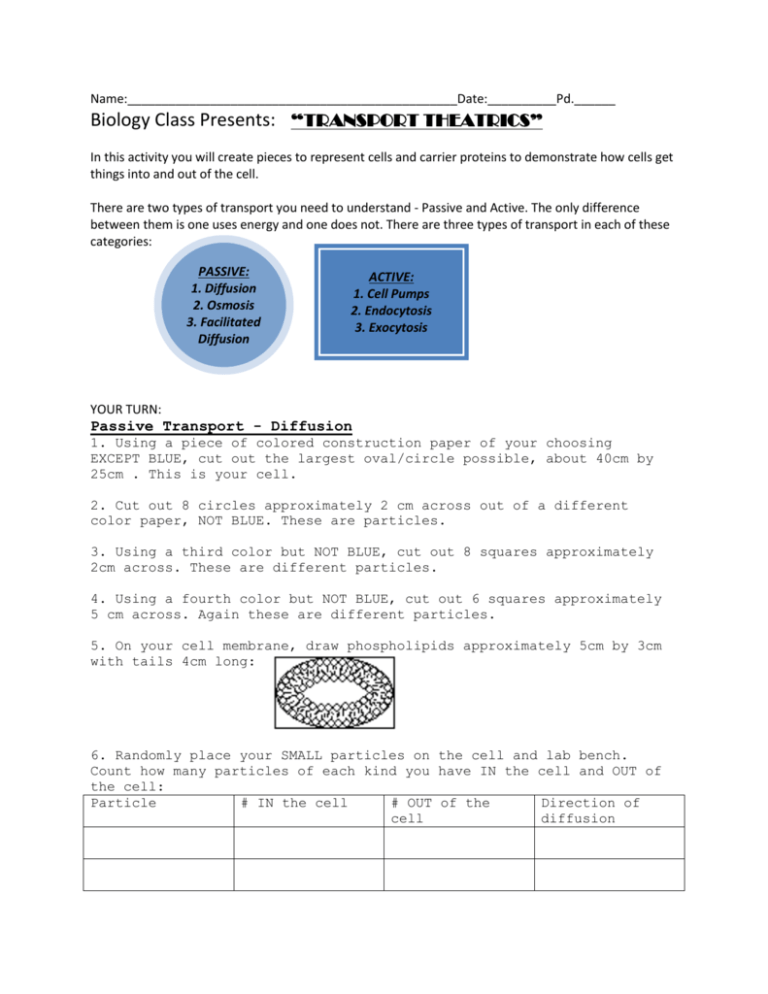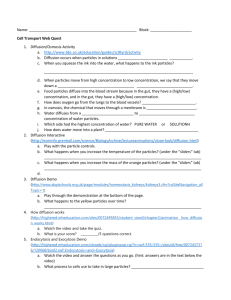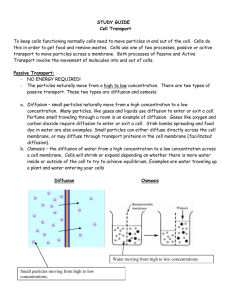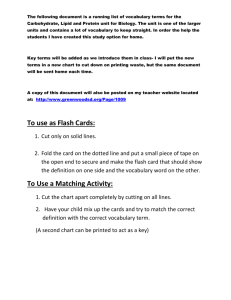transport theatrics - Delran High School
advertisement

Name:________________________________________________Date:__________Pd.______ Biology Class Presents: “TRANSPORT THEATRICS” In this activity you will create pieces to represent cells and carrier proteins to demonstrate how cells get things into and out of the cell. There are two types of transport you need to understand - Passive and Active. The only difference between them is one uses energy and one does not. There are three types of transport in each of these categories: PASSIVE: 1. Diffusion 2. Osmosis 3. Facilitated Diffusion ACTIVE: 1. Cell Pumps 2. Endocytosis 3. Exocytosis YOUR TURN: Passive Transport - Diffusion 1. Using a piece of colored construction paper of your choosing EXCEPT BLUE, cut out the largest oval/circle possible, about 40cm by 25cm . This is your cell. 2. Cut out 8 circles approximately 2 cm across out of a different color paper, NOT BLUE. These are particles. 3. Using a third color but NOT BLUE, cut out 8 squares approximately 2cm across. These are different particles. 4. Using a fourth color but NOT BLUE, cut out 6 squares approximately 5 cm across. Again these are different particles. 5. On your cell membrane, draw phospholipids approximately 5cm by 3cm with tails 4cm long: 6. Randomly place your SMALL particles on the cell and lab bench. Count how many particles of each kind you have IN the cell and OUT of the cell: Particle # IN the cell # OUT of the Direction of cell diffusion Be ready to explain why you decided the particles would move the way they do. What about the larger particles, can they diffuse easily? Is energy used in this process? Passive Transport - Osmosis 1. USING BLUE PAPER cut out 10 water drops about 2cm by 3 cm. 2. Remove all particles from your work area (but keep them for later) and randomly place the water drops. Record how many are on the inside and how many are on the outside: # in the cell # out of the cell Direction of osmosis Water Drops 3. Using one of the colors of the small particles from diffusion, place 6 particles in the cell and 2 outside. Then place 8 waters outside and 2 waters inside. THIS IS A HYPOTONIC SOLUTION. Water wants to move INTO the cell. 4. Now place the cell in a HYPERTONIC SOLUTION. Put 6 particles outside the cell and 2 inside. Place 2 waters outside and 8 inside. Which way does the water want to go? 5. Finally place 4 particles in the cell. Place 4 particles out of the cell. And place 5 waters both in and out of the cell. THIS IS AN ISOTONIC SOLUTION. Where does the water want to move? Be able to explain what is the difference between osmosis and diffusion. Be able to show a hypotonic, hypertonic and isotonic solution. What will needs to happen to the cell for all the water to fit in the middle? Passive Transport - Facilitated diffusion Remember those LARGER particles? How can we get them in the cell? 1. Using a different color then you have already used (if possible) make a 2 carrier proteins 7cm across and 12cm long. 2. Place the carrier proteins on the cell membrane and hold in place with a paper clip. 3. Randomly place the larger particles on the cell, and record how many are where: # in the cell # out of the cell Direction of diffusion Larger Particles 4. Now demonstrate how the larger particles can now slide through the membrane and reach equilibrium. Be able to show and explain how the carrier protein is helping but not using energy. Active transport - Endocytosis/Exocytosis Put your cell aside and get a piece of string. Keep your larger particles and water available as well as your carrier proteins. 1. Cut the string to have one piece 15cm long and the other piece really long. 2. Form the long string into a circle to represent the cell membrane (not as magnified because not we can’t see the phospholipid bilayer). Include the cut piece like it wasn’t cut off. 3. Using a larger particle push the cut piece into the cell, form a vesicle and ‘heal’ the cell membrane. THIS IS ENDOCYTOSIS 4. Now that you have a vesicle in the cell with a larger particle in it, demonstrate EXOCYTOSIS by bringing the vesicle to the membrane, join the membranes together and ‘dump’ out the particle. Be able to explain why these processes would occur. Be able to demonstrate pinocytosis and phagocytosis. Does the cell use energy for this? How so? How is this different from a cell pump? Name:________________________________________________Date:__________Pd.______ Biology Class Presents: “TRANSPORT THEATRICS” Teacher Notes: DiffusionExplain why the particles move the way they do. Present new scenario Can the larger particles fit through? OsmosisWhat is the difference between osmosis and diffusion. If water keeps coming in, what could eventually happen to the cell? (break/burst/lyse/explode) Hypotonic Hypertonic Isotonic Facilitated diffusionIdentify carrier protein Explain why a protein is needed Demonstrate Active transportdemonstrate discuss note to me - box top and shake/shift to show kinetic energy of particles? start with separated then shake to show equilibrium? Parts made: 8 color a 8 color b 6 larger 10 water one cell 2 carrier proteins string paper clips









